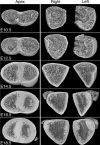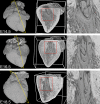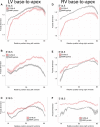Morphogenesis of myocardial trabeculae in the mouse embryo
- PMID: 27020702
- PMCID: PMC4948049
- DOI: 10.1111/joa.12465
Morphogenesis of myocardial trabeculae in the mouse embryo
Abstract
Formation of trabeculae in the embryonic heart and the remodelling that occurs prior to birth is a conspicuous, but poorly understood, feature of vertebrate cardiogenesis. Mutations disrupting trabecular development in the mouse are frequently embryonic lethal, testifying to the importance of the trabeculae, and aberrant trabecular structure is associated with several human cardiac pathologies. Here, trabecular architecture in the developing mouse embryo has been analysed using high-resolution episcopic microscopy (HREM) and three-dimensional (3D) modelling. This study shows that at all stages from mid-gestation to birth, the ventricular trabeculae comprise a complex meshwork of myocardial strands. Such an arrangement defies conventional methods of measurement, and an approach based upon fractal algorithms has been used to provide an objective measure of trabecular complexity. The extent of trabeculation as it changes along the length of left and right ventricles has been quantified, and the changes that occur from formation of the four-chambered heart until shortly before birth have been mapped. This approach not only measures qualitative features evident from visual inspection of 3D models, but also detects subtle, consistent and regionally localised differences that distinguish each ventricle and its developmental stage. Finally, the combination of HREM imaging and fractal analysis has been applied to analyse changes in embryonic heart structure in a genetic mouse model in which trabeculation is deranged. It is shown that myocardial deletion of the Notch pathway component Mib1 (Mib1(flox/flox) ; cTnT-cre) results in a complex array of abnormalities affecting trabeculae and other parts of the heart.
Keywords: cardiac embryology; cardiogenesis; developmental biology; non-compaction cardiomyopathy.
© 2016 The Authors. Journal of Anatomy published by John Wiley & Sons Ltd on behalf of Anatomical Society.
Figures







References
-
- Axel L (2004) Papillary muscles do not attach directly to the solid heart wall. Circulation 109, 3145–3148. - PubMed
-
- Captur G, Lopes LR, Patel V, et al. (2014) Abnormal cardiac formation in hypertrophic cardiomyopathy: fractal analysis of trabeculae and preclinical gene expression. Circ Cardiovasc Genet 7, 241–248. - PubMed
-
- Carlhäll CJ, Bolger A (2010) Passing strange: flow in the failing ventricle. Circ Heart Fail 3, 326–331. - PubMed
-
- Filipoiu FM(2014) Atlas of Heart Anatomy and Development. Springer‐Verlag London: Springer Science & Business Media.
Publication types
MeSH terms
Grants and funding
LinkOut - more resources
Full Text Sources
Other Literature Sources
Research Materials

